issue contents
April 2011 issue

Cover illustration: Structure of human sentrin-specific protease 1 with bound cobalt (Rimsa et al., p. 442).
structural communications
A protein crystallographic data collection using the PETRA II source sets the record in crystallographic resolution for a biological macromolecule (0.48 Å) for the small protein crambin and increases available data for refinement by a factor of 1.5. The quality of the data collected is evident by comparing the merging R factor between two different crambin data sets, collected from different crystals and using different beamlines and protocols (6%) and the final crystallographic R factor of 12.7% for the model refinement.
PDB reference: crambin, 3nir
EndoD from S. pneumoniae is a large multimodular virulence factor that contains a putative carbohydrate-binding module (CBM). Here, the structure of the putative CBM is described.
PDB reference: carbohydrate-binding module of EndoD, 2xqx
The cocrystallization of recombinant full-length human BChE with cocaine yields a 3.0 Å resolution structure of the complex with the hydrolysis product benzoic acid. The benzoate is positioned in the acyl cavity, where it appears to forms a hydrogen bond to the active-site Ser.
PDB reference: 3o9m
The structure of a mutant β toxin from S. aureus in which a hydrophobic β-hairpin has been deleted shows unanticipated domain swapping leading to the formation of conformationally flexible dimers.
PDB reference: mutant β toxin from Staphylococcus aureus, 3k55
Crystallographic analysis of the human SENP1 catalytic domain identified a well ordered Co2+ ion that contributes to intermolecular interactions relevant to crystallization of the enzyme. The presence of this ion was overlooked in previous studies.
The structure of peptidyl-tRNA hydrolase from F. tularensis, the causative agent of tularemia, is comparable to that of other bacterial peptidyl-tRNA hydrolases, with most residues in the active site conserved amongst the family. The resultant reagents, structural data, and analyses provide essential information for structure-based design of novel inhibitors for this class of proteins.
PDB reference: peptidyl-tRNA hydrolase, 3nea
crystallization communications
The α isoform of human autotaxin has been crystallized. Diffraction data were collected to 3.0 Å resolution using synchrotron radiation.
The Enteroaggregative Escherichia coli AAF/II pilus plays an important role in the attachment to and invasion of the host during the initial stages of colonization. Here, the major adhesive subunit of AAF/II has been crystallized at pH 3.4 and diffraction data have been collected to 2.1 Å resolution.
In this study, the CIDE domains of Drep2 and Drep3 from Drosophila melanogaster were purified in Escherichia coli, after which they formed a stable complex in vitro and were crystallized by the hanging-drop vapour-diffusion method.
The human histone deacetylase sirtuin 1 was expressed and purified. Crystals were obtained and diffracted to 3.45 Å in space group P622.
The expression, purification and crystallization of the trans-acting acyltransferase PksC from the bacillaene hybrid polyketide synthase/nonribosomal peptide synthetase is described. The crystals belonged to the orthorhombic space group P212121 and diffracted to 1.44 Å resolution.
Details of the expression and crystallization of the N-terminal fragment of Als9-2, an adhesin from the human commensal/pathogenic fungus C. albicans, are reported. Preliminary analysis of the collected X-ray data is also discussed.
The cloning, overexpression, purification, crystallization and preliminary X-ray diffraction analysis of an inositol monophosphatase family protein (SAS2203) from S. aureus MSSA476 is reported.
L-Amino-acid oxidase from B. atrox has been crystallized by combining seeding with oil modulation of vapour equilibration. A complete data set has been collected to 2.3 Å resolution from a native crystal.
5-(Hydroxyethyl)-4-methylthiazole kinase from S. aureus, which is essential to vitamin B1 metabolism, has been crystallized in space group P1. The crystals diffracted to 2.1 Å resolution.
The equine infectious anaemia virus gp45 ectodomain was cloned, expressed and crystallized. Preliminary crystallographic analysis showed that the protein belonged to space group P63 and contained one molecule per asymmetric unit.
This work describes the expression, purification, circular dichroism spectrum and crystallization of a central domain from human Splicing Factor 1. A native, 2.5 Å resolution data set is reported.
The novel N-terminal carbohydrate-binding module of the family 5 glycoside hydrolase endoglucanase Cel5A from E. cellulosolvens has been crystallized and MAD data have been collected to 1.75 Å resolution.
The catalytic domain of a novel chitinase, which is a member of GH family 23, from the moderately thermophilic bacterium Ralstonia sp. A-471 was crystallized and diffraction data were collected to 1.85 Å resolution.
The fungal β-N-acetylhexosaminidase from A. oryzae was crystallized and diffraction data were collected from two crystal forms to 3.2 and 2.4 Å resolution, respectively.
CheW from T. maritima has been crystallized (space group P63, unit-cell parameters a = b = 61.265, c = 361.045 Å). Diffraction data have been collected to 3.1 Å resolution using synchrotron X-ray radiation.
Recombinant chlorocatechol 1,2-dioxygenase from P. putida has been crystallized in the presence of polyethylene glycol as the precipitant agent and magnesium acetate as an additive. The structure was solved by the MR-SAD approach.
The N-terminal domain of the human ribosomal protein L7a (RPL7a) was crystallized. The crystals were found to belong to the tetragonal space group P4122 or P4322, with unit-cell parameters a = 92.28, b = 92.28, c = 236.59 Å. The crystals were obtained at 293 K and diffracted to a resolution of 3.5 Å.
In order to obtain molecular insights into the methanol-oxidizing system of M. aminisulfidivorans, a native heterotetrameric α2β2 methanol dehydrogenase complex was directly purified from M. aminisulfidivorans MPT grown in the presence of methanol and crystallized.
The colicin M immunity protein Cmi protects E. coli cells against killing by colicin M. The Cmi protein was produced for structure determination and crystals were obtained which diffracted to high resolution.
A recombinant cyclic imide hydrolase from P. putida YZ-26 has been crystallized by the hanging-drop method. This will be helpful in understanding the role of CIH in pyrimidine metabolism and organic acid bioconversion.
A galactose specific lectin was purified from the seeds of a tropical tree, Butea monosperma. Its X-ray structure was solved by molecular replacement.


 journal menu
journal menu












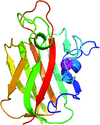



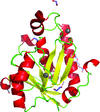
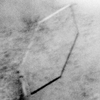




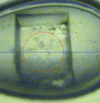











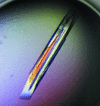



![[publBio]](/logos/publbio.gif)





